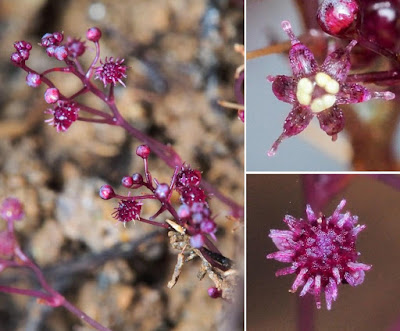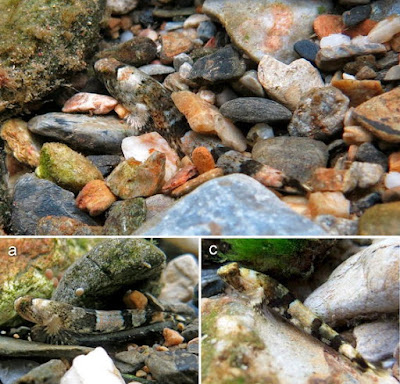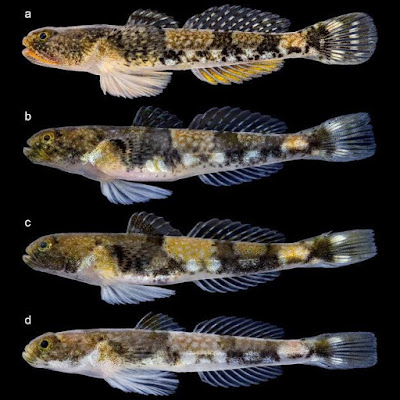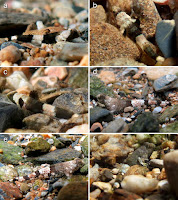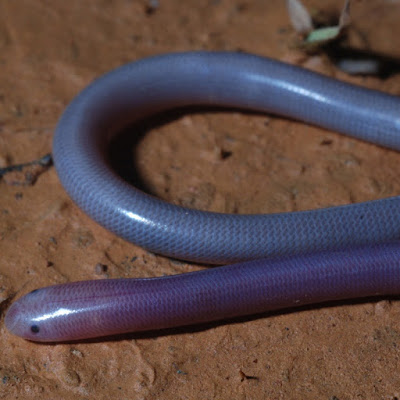[Most Recent Entries] [Calendar View]
Wednesday, July 26th, 2017
| Time | Event | ||||
| 2:04a | [Botany • 2017] Sciaphila sugimotoi • A New Mycoheterotrophic Plant (Triuridaceae) from Ishigaki Island, Japan
Abstract A new species of Sciaphila (Triuridaceae), Sciaphila sugimotoi Suetsugu & T. Nishioka, is described and illustrated from Ishigaki Island, Okinawa Prefecture, Japan. The new species is similar to S. arfakiana in having a stipitate globose to ellipsoid knob without hairs in apices of all male perianth segments. However, it is clearly distinguishable by its shorter pedicel, filament-connective not extended and thick stem. A key to the Japanese Sciaphila based on the whole flower characteristics and stylar characteristics, are provided for easy identification of these rare mycoheterotrophic plants. Keywords: Distribution, mycoheterotrophic plants, new species, Sciaphila, taxonomy, Triuridaceae, Ryukyu, Monocots
Sciaphila sugimotoi Suetsugu & T. Nishioka, sp. nov. Type:— JAPAN. Ryukyu. Okinawa Pref., Ishigaki City, Hirae, alt ca. 180m, 18 October 2016, T. Sugimoto s.n. (holotype KYO!; isotype OSA!). Diagnosis:— Sciaphila sugimotoi is similar to Sciaphila arfakiana Beccari (1890: 337), but it differs by its shorter pedicel, its filamentconnective not extended and its thick stem. Etymology:— The new species is named after Mr. Takaomi Sugimoto, who collected ample specimens of this new species for the comparative study. Phytotaxa. 314(2); 279–284. DOI: 10.11646/phytotaxa.314.2.10 New non-photosynthesizing plant species discovered on Ishigaki island, J... eurekalert.org/e/7ttW via @KobeU_Global @EurekAlert | ||||
| 3:06a | [Ichthyology • 2017] Review of Schismatogobius (Gobiidae) from Japan, with the Description of A New Species, Schismatogobius ninja
Abstract Three species of Schismatogobius de Beaufort 1912, distinguished by their morphology and mitochondrial DNA sequences, were found in freshwater streams in the Ryukyu Archipelago, Japan. Although two species were previously known from Japan (S. roxasi Herre 1936 and S. ampluvinculus Chen, Shao, and Fang 1995), the taxonomy needs to be revised. To identify these species, the holotype morphology of S. marmoratus (Peters 1868), S. bruynisi de Beaufort 1912, and S. roxasi, originally described from the Philippines and Indonesia, were examined and re-described here, because relatively little information about their diagnostic characters was provided in the original descriptions. The three Japanese species were identified as S. ampluvinculus, S. marmoratus, and a new species. They were distinguished from each other and from their congeners by the banding pattern of the body, markings on the pectoral fins, pigment patterns on the ventral surface of the head and pelvic fin, body depth at the pelvic-fin origin, pre-anal length, and pectoral-fin ray counts. Although the new species had been regarded as S. roxasi in previous publications, we show that it is actually not S. roxasi and that it also differs from all other nominal species of Schismatogobius. This is described as a new species, Schismatogobius ninja. Additionally, this is the first record of S. marmoratus from Japan. Keywords: Schismatogobius, Gobiidae, New species, Mitochondrial genome, Ryukyu Archipelago Schismatogobius ninja Maeda, Saeki, and Satoh, sp. nov. (Japanese name: Eso-haze) Diagnosis. The new species is distinguished by a combination of the following characters: pectoral-fin rays 15–16 (usually 15); body relatively slender (depth at pelvic-fin origin 16.9–19.5% of SL); trunk relatively short (pre-dorsal length 35.5–39.1% of SL; pre-anal length 53.2–56.7% of SL; pre-anal-fin length 58.4–61.0% of SL; length of second dorsal-fin base 26.5–29.0% of SL; length of anal-fin base 22.3–25.9% of SL); two dark brown, transverse bands on posterior half of the body; pectoral fin with 1–5 black spots along each ray; pectoral fin often with one large, black vertical blotch on upper part, but blotch not extending to distal part; isthmus and gular region almost cream or white, often with some melanophores, but not densely pigmented; pelvic fin usually almost without pigmentation, but often lightly pigmented in larger males. Distribution. All specimens described here with mitochondrial DNA sequences were collected from Okinawa Island in the Ryukyu Archipelago. Thirty-five non-type specimens collected from Okinawa, Ishigaki, and Iriomote islands were also identified as the new species, Schismatogobius ninja. Many authors reported “eso-haze” (regarded as Schismatogobius roxasi) in Japan and the range often included Amami-oshima Island, in addition to Okinawa, Ishigaki, and Iriomote islands (Yoshigou 2014). These records need to be verified by reexamination of the specimens. This species seems to have often been misidentified as “Schismatogobius ampluvinculus” (see Distribution section of S. ampluvinculus). In conclusion, the verified localities of S. ninja in Japan are Okinawa, Ishigaki, and Iriomote islands, but it may be found on some other islands in the Ryukyu Archipelago. Ecology. All specimens were collected from the lower freshwater reaches of the streams, at 50 to 1,300 m from the upper limit of tidal fluctuations. This species was found on coarse sand and gravel bottoms of shallow areas (depth usually 5–30 cm) around rapids. Typical habitat was at the ends of the rapids (transitional areas from rapid to pool) with steady flow. These gobies usually stay on the bottom and often bury half of their body in the substratum (Fig. 10e). They prefer substrates with free gravel granules which can be moved easily by water flow, and they do not inhabit silty substrates. Body markings perfectly camouflage them on the gravel bottom of their habitats (Fig. 10e); therefore, they are hard to detect if they remain motionless. Schismatogobius ninja is often found with S. ampluvinculus, and sometimes with Schismatogobius marmoratus. The most abundant syntopic species was Rhinogobius nagoyae Jordan and Seale 1906. Other gobies, such as Stiphodon percnopterygionus Watson and Chen 1998, Sicyopterus lagocephalus (Pallas 1770), Glossogobius illimis Hoese and Allen 2012, and Luciogobius ryukyuensis Chen, Suzuki, and Senou 2008 and amphidromous pipefish, Microphis leiaspis (Bleeker 1854), were also frequently observed with Schismatogobius ninja. Etymology. Although the new species shows attractive coloration when viewed against a simple background, they are very cryptic against the gravel substrates of their habitats. The stealthy capacity of this species reminds us of Japanese “ninja,” which were known as masters of camouflage. Therefore, the new species is named Schismatogobius ninja. The new specific name is a noun in apposition.
Taxonomy of Japanese species Schismatogobius ninja Maeda, Saeki, and Satoh, sp. nov. (Japanese name: Eso-haze) Schismatogobius ampluvinculus Chen, Shao, and Fang 1995 (Japanese name: Shima-eso-haze) Schismatogobius marmoratus (Peters,1868) (New Japanese name: Kaeru-eso-haze) Ken Maeda, Toshifumi Saeki, Chuya Shinzato, Ryo Koyanagi and Nori Satoh. 2017. Review of Schismatogobius (Gobiidae) from Japan, with the Description of A New Species. Ichthyological Research. xx; 1–22. DOI: 10.1007/s10228-017-0593-4 | ||||
| 4:39p | [Herpetology • 2017] New Species of Blindsnake of the Genus Gerrhopilus (Squamata: Gerrhopilidae) from the offshore islands of Papua New Guinea
Abstract I describe four new species of blindsnake of the genus Gerrhopilus from islands off the southeastern tip of New Guinea and from New Ireland to the northeast. All have ventral keels on the rostral scale, and most have previously been assigned in their respective museum collections to the species G. depressiceps. Examination of available specimens shows G. depressiceps to be a composite of species, and I emend the diagnosis of that species based on the holotype and one additional specimen from northeastern New Guinea. The species described as new here differ from G. depressiceps and from each other in a series of features, including shape of the snout, shape of the rostral scale, numbers of mid-dorsal scale rows, reduction patterns in longitudinal scale rows, body mass, degree of eye development, and color pattern. The new species all inhabit islands remote from the known range of G. depressiceps on New Guinea and have likely been separated from that species for millions of years. Keywords: Reptilia, Gerrhopilus depressiceps, External morphology, D’Entrecasteaux Islands, Milne Bay Province, New Ireland Fred Kraus. 2017. New Species of Blindsnakes (Squamata: Gerrhopilidae) from the offshore islands of Papua New Guinea. Zootaxa. 4299(1); 75-94. DOI: 10.11646/zootaxa.4299.1.3 |
| << Previous Day |
2017/07/26 [Calendar] |
Next Day >> |
